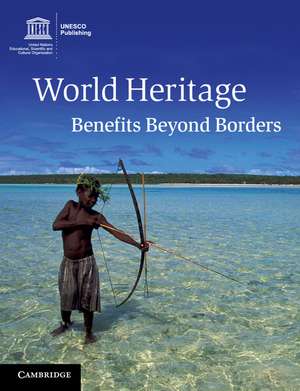World Heritage: Benefits Beyond Borders
Editat de Amareswar Gallaen Limba Engleză Paperback – 21 noi 2012
Preț: 300.21 lei
Preț vechi: 330.37 lei
-9% Nou
Puncte Express: 450
Preț estimativ în valută:
57.45€ • 59.53$ • 47.95£
57.45€ • 59.53$ • 47.95£
Carte indisponibilă temporar
Doresc să fiu notificat când acest titlu va fi disponibil:
Se trimite...
Preluare comenzi: 021 569.72.76
Specificații
ISBN-13: 9781107610750
ISBN-10: 1107610753
Pagini: 376
Ilustrații: 217 colour illus.
Dimensiuni: 191 x 246 x 17 mm
Greutate: 0.82 kg
Editura: Cambridge University Press
Colecția Cambridge University Press
Locul publicării:New York, United States
ISBN-10: 1107610753
Pagini: 376
Ilustrații: 217 colour illus.
Dimensiuni: 191 x 246 x 17 mm
Greutate: 0.82 kg
Editura: Cambridge University Press
Colecția Cambridge University Press
Locul publicării:New York, United States
Cuprins
Foreword by the UNESCO Director-General Irina Bokova; List of acronyms; Introduction; Part I. Bridging Nature and Culture: 1. Conservation of World Heritage and community engagement in a transboundary Biosphere Reserve: Djoudj National Bird Sanctuary, Senegal; 2. Community engagement in safeguarding the world's largest reef: Great Barrier Reef, Australia; 3. Living World Heritage: Škocjan Caves, Slovenia; 4. Challenges of protecting island ecosystems: Socotra Archipelago, Yemen; 5. Cultural landscapes: challenges and possibilities: Vegaøyan – the Vega Archipelago, Norway; Part II. Urbanism and Sustainable Heritage Development: 6. Heritage and communities in a small island developing state: historic Bridgetown and its garrison, Barbados; 7. The Red City: Medina of Marrakesh, Morocco; 8. Capacity-building for sustainable urban development: town of Luang Prabang, Lao People's Democratic Republic; 9. World Heritage in poverty alleviation: Hoi an ancient town, Vietnam; 10. Responsible local community in historic centres: historic centre (Old Town) of Tallinn, Estonia; 11. An exceptional picture of a Spanish colonial city: historic centre of Santa Cruz de Mompox, Colombia; Part III. Integrated Planning and Indigenous Engagement: 12. Homelands of the Mijikenda people: sacred Mijikenda Kaya forests, Kenya; 13. Reconnection and reconciliation in Canadian Rocky Mountain parks: Jasper National Park, Canada; 14. Legacy of a chief: Chief Roi Mata's Domain, Vanuatu; 15. Living cultural landscape: rice terraces of the Philippine Cordilleras; 16. The strength of a cultural system: Cliff of Bandiagara (Land of the Dogons), Mali; Part IV. Living Heritage and Safeguarding Outstanding Universal Value: 17. Aligning national priorities and World Heritage conservation: iSimangaliso Wetland Park, South Africa; 18. Participatory methodologies and indigenous communities – project-based learning: Sian Ka'an, Mexico; 19. Village on the winding river: historic villages of Korea – Hahoe and Yangdong; 20. World Heritage and Chinese diasporas: Kaiping Diaolou and villages, China; 21. Role of fisheries and ecosystem-based management: Shiretoko, Japan; Part V. More than the Monumental: 22. Dahshur villages in community development: Memphis and its necropolis – the pyramid fields from Giza to Dahshur, Egypt; 23. Sustainable development in a Dutch-German World Heritage site: the Wadden Sea; 24. World Heritage site status – a catalyst for heritage-led sustainable regeneration: Blaenavon industrial landscape, United Kingdom; 25. World Heritage in poverty alleviation: Serra da Capivara National Park, Brazil; 26. Angkor Archaeological Park and communities: Angkor, Cambodia; Pathways to sustainable development; References; List of contributors; Photo credits; Index.
Recenzii
'There is plenty of solid evidence presented here to justify the conclusion that World Heritage has become a vehicle for sustainable development.' David Harmon, Biological Conservation
Descriere
This thematic collection of 26 case studies provides a thorough understanding of World Heritage in the context of sustainable development.
